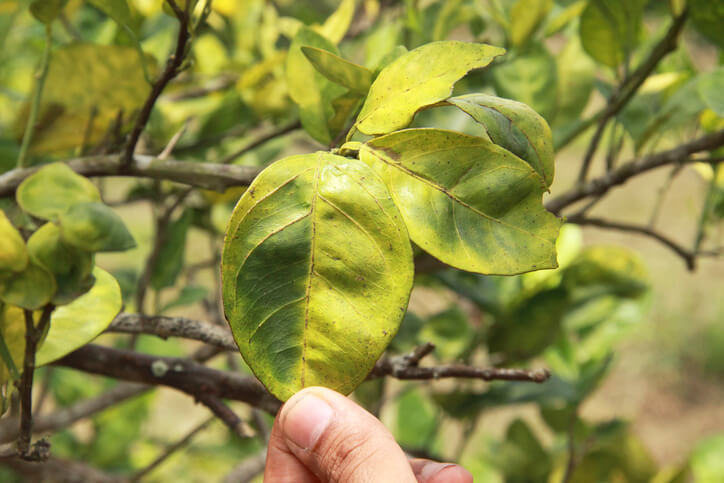TREE EDUCATION

Trees experience a number of different reactions to factors within the surrounding environment — among these reactions is tree stress. Air pollution, soil conditions, insects, and weather patterns are among the wide range of tree stress catalysts. Trees of all age and stages of growth can experience tree stress, but knowing how to identify and treat the symptoms of this condition is vital both to tree health and longevity. One thing to keep in mind is the occurrence of tree stress doesn’t necessarily indicate that the affected tree is dead or dying. A certified arborist in Gainesville with SkyFrog Tree Service can help your trees recover from a stress event and provide you with tips on how to prevent the future occurrence of tree stress.
Knowing how to identify the common signs of tree stress is the first step in recovery to any tree. During an appointment for tree trimming services, professional arborists will examine the tree for various signs of stress and thereafter, provide a recommendation for treatment.
A tree with sparse leaves or leaves that grow in patches is a primary indicator for tree stress. Branches with buds and no leaves typically indicate that the root system is restricted and/or the condition of the soil is poor, resulting in a lack of sufficient nutrients and reduced leaf growth.
Some tree species, such as oak trees, naturally develop small cracks or splits in the trunk as the tree grows. However, drought; incorrect pruning or trimming; lightning damage; and root cutting can cause damaging cracks or splits to form as the tree becomes more stressed.
Certain types of fungi, such as honey fungus, can deteriorate the health of a tree in a short amount of time. These yellow-brown mushrooms grow in clusters at the base of a tree and have a distinct white ring around the stem and flat tops. Honey fungus thrives in overwatered areas often located at the tree base. Signs of this type of infestation also include concentrated and persistent flower or fruit growth; white fungal growth under the tree bark; pale and small leaves; and fungi growth with sweet odors.
Early dropping of leaves can occur during the summer or early fall — far before most trees should lose their leaves. This issue is usually related to an overcrowded canopy, disease or pest infestation or insufficient moisture levels. Conversely, the leaves may suddenly change colors for a variety of reasons, which include soil compaction; the loss of mineral recycling and nutrients; a restricted root system; disease and/or a pest infestation; and either mechanical or nature damage to the tree.
A change in leaf color to brown or yellow can be caused by overwatering due to an excess in rainfall, a sunburn, or a fungal infection. A fungal infection can occur on its own, but it is more prevalent in cases of overwatering to trees.
Tree stress treatment often depends on the circumstances of the individual tree and the results of a comprehensive evaluation from SkyFrog Tree Service. In certain cases in which treatment is ineffective, emergency tree removal may be necessary to avoid potential safety hazards and damage to people and surrounding structures by the tree. Call SkyFrog Tree Service today to schedule an appointment.
If the tree is stressed due to a lack of moisture, a Gainesville arborist with SkyFrog Tree Service may recommend a custom watering plan. This may include slowly watering the tree for at least an hour once every few weeks to allow the water to soak deeply into the root system and the surrounding soil. A slow absorption rate minimizes further stress to the tree. which also reduces the risk of disease and infestation of pests.
The longer a stressed tree is left without appropriate treatment, the more susceptible it becomes to developing a tree disease or an insect infestation. SkyFrog Tree Service will create a custom treatment plan that eliminates any occurrence of disease or pests while taking preventive measures to avoid a future recurrence of these problems.
This routine part of our tree care services can also be an effective tree stress treatment. Our arborists will evaluate the tree and determine which branches and/or limbs require pruning and which portions need trimming. When performed professionally, pruning and trimming can improve the overall health of the tree and prevent tree stress.
Adding a new layer of mulch or replacing existing mulch can help with nursing a stressed tree back to health. The mulch layer regulates the temperature of year-round soil to prevent extreme changes that may cause stress to the entire tree structure. However, avoid placing mulch against the trunk of the tree — called volcano mulching — as it invites insect and pests.
Soil conditions play a direct role in the health of a tree. If the surrounding soil has been compacted — such as is common after a construction project — the roots will struggle to gather enough oxygen and water from the soil. This inhibits root growth, which in turn inhibits adequate development and growth of all parts of the tree. A tree service company that offers a range of arboreal services, such as SkyFrog Tree Service, can test the soil for nutrient levels and provide recommendations to improve the condition of the soil for overall healthier trees.
For more than four decades, SkyFrog Tree Service has seen first-hand the role summer care plays to keep trees healthy throughout the year. Our certified team uses the latest tools, techniques, and tree care information to give you many summers of enjoyment. To schedule an appointment for tree service Gainesville residents can count on, contact SkyFrog Tree Service today!